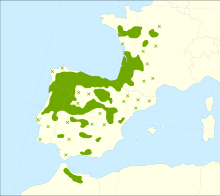Quercus pyrenaica
| Pyrenean oak | |
|---|---|
| | |
| Scientific classification | |
| Kingdom: | Plantae |
| (unranked): | Angiosperms |
| (unranked): | Eudicots |
| (unranked): | Rosids |
| Order: | Fagales |
| Family: | Fagaceae |
| Genus: | Quercus |
| Section: | Mesobalanus |
| Species: | Q. pyrenaica |
| Binomial name | |
| Quercus pyrenaica Willd. 1805 not Steven 1813 | |
 | |
| Distribution map | |
| Synonyms [1] | |
|
List
| |
Quercus pyrenaica, commonly known as Pyrenean oak,[2] is a tree native to southwestern Europe and northwestern Africa. Despite its common name, it is rarely found in the Pyrenees Mountains and is more abundant in central and southern Spain.
Trees grow slowly to 20 metres (66 ft), or rarely 25 m (82 ft) in optimal conditions. In poor soils, it is often found as a bush or small tree. Roots frequently produce suckers.
Leaves have short petioles and are deeply and irregularly lobed, with four to eight pairs of lobes per leaf. There are stellate hairs on both sides of the leaf. Leaves are marcescent, turning brown but remaining on the tree all winter until new leaves emerge in the spring.
The oak is cultivated as an ornamental tree for gardens and parks.
References
- ↑ "The Plant List: A Working List of All Plant Species".
- ↑ "BSBI List 2007". Botanical Society of Britain and Ireland. Archived from the original (xls) on 2015-02-25. Retrieved 2014-10-17.
External links
 Media related to Quercus pyrenaica at Wikimedia Commons
Media related to Quercus pyrenaica at Wikimedia Commons